The Jeddah Tower, set to stand over 1,000 meters (3,281 feet) tall when finished, aims to be the world's tallest building. Its construction began in April 2013 but faced delays, stopping in 2018. The tower recently resumed building efforts after securing new financing. The skyscraper’s design was created by Adrian Smith + Gordon Gill Architecture which draws aesthetic and structural influence from regional themes like desert plant shoots and Bedouin tent fabric. Jeddah Tower's almost kilometer-high ambitions intend to spark economic growth and tourism in Jeddah as its tapered silhouette mitigates wind vortex shedding. Jeddah Tower’s structure applies buttressed core principles and very high-strength reinforced concrete. The skyscrapers' intended mixed-use functions span hotels, luxury residences, offices, shops, restaurants, and an observation deck as well as advanced technologies like double-decker elevators. The Jeddah Tower's unprecedented height may consummate decades of architectural vision is finally completed.
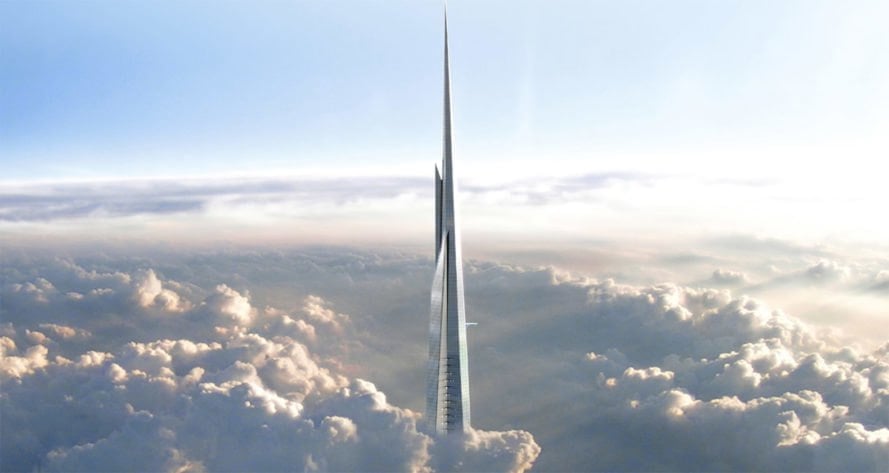
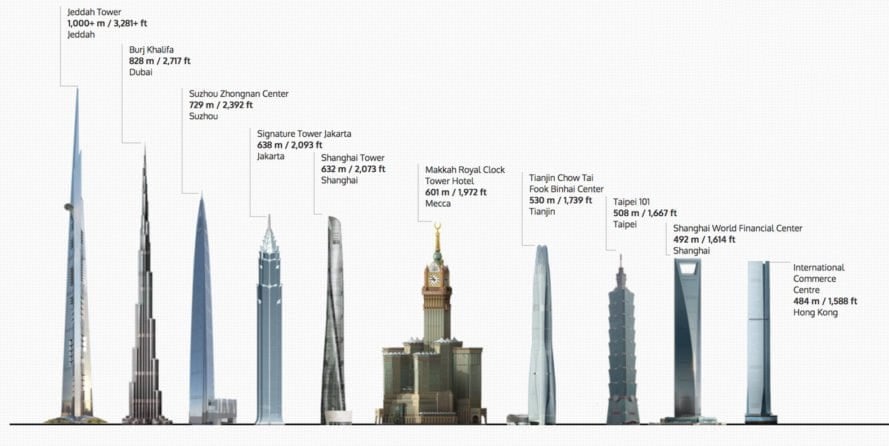
What is Jeddah Tower?
The Jeddah Tower, formerly known as the Kingdom Tower, is a skyscraper under construction in Jeddah, Saudi Arabia that is planned to be the world’s tallest building upon completion. The tower’s construction started on Monday, April 1, 2013. It is being built by the Jeddah Economic Company, which was formed in 2009 specifically to develop the Jeddah Tower and the surrounding Jeddah Economic City. The Jeddah Tower’s architectural design was created by Adrian Smith + Gordon Gill Architecture, an American firm led by Adrian Smith. Smith was previously the lead architect for the Burj Khalifa in Dubai while he was working at Skidmore, Owings & Merrill.
The Jeddah Tower is planned to have a height of at least 1,000 meters (3,281 feet). The tower’s exact height is being kept confidential during construction, similar to how the final height of the Burj Khalifa was not revealed until its completion. The Jeddah Tower, at 1,000 meters (3,281 feet), would be 180 meters (591 feet) taller than the 828-meter (2,717-foot) Burj Khalifa, which is currently the tallest building in the world.
The Jeddah Tower’s inside gross floor area is planned to be 243,866 square meters (2,624,950 square feet). The tower’s occupied height when finished is projected to be 668 meters (2,192 feet) on the top floor and the outdoor observation deck is planned for 652 meters (2,139 feet). The building’s foundations extend 15 meters (50 feet) deep and cover an area of over 7,500 square meters (81,000 square feet). Its final planned weight is estimated at over 900,000 metric tons (990,000 short tons).
The Jeddah Tower design incorporates several unique features. Its triangular footprint with smooth, sloped exterior walls is intended to reduce wind loads and vortex shedding. The tower’s tapering shape going up is also more aerodynamic. Its notches in the façade create shaded outdoor terraces on each side. The skyscraper will use high-strength concrete in parts of the core and has a highly integrated steel frame with wall panels, designed to withstand disasters. The Jeddah Tower’s advanced elevator systems will transport occupants efficiently, with double-decker cars serving an observation deck and sky terrace. Its organic design aims to symbolize Saudi Arabia's growth and Jeddah's gateway location.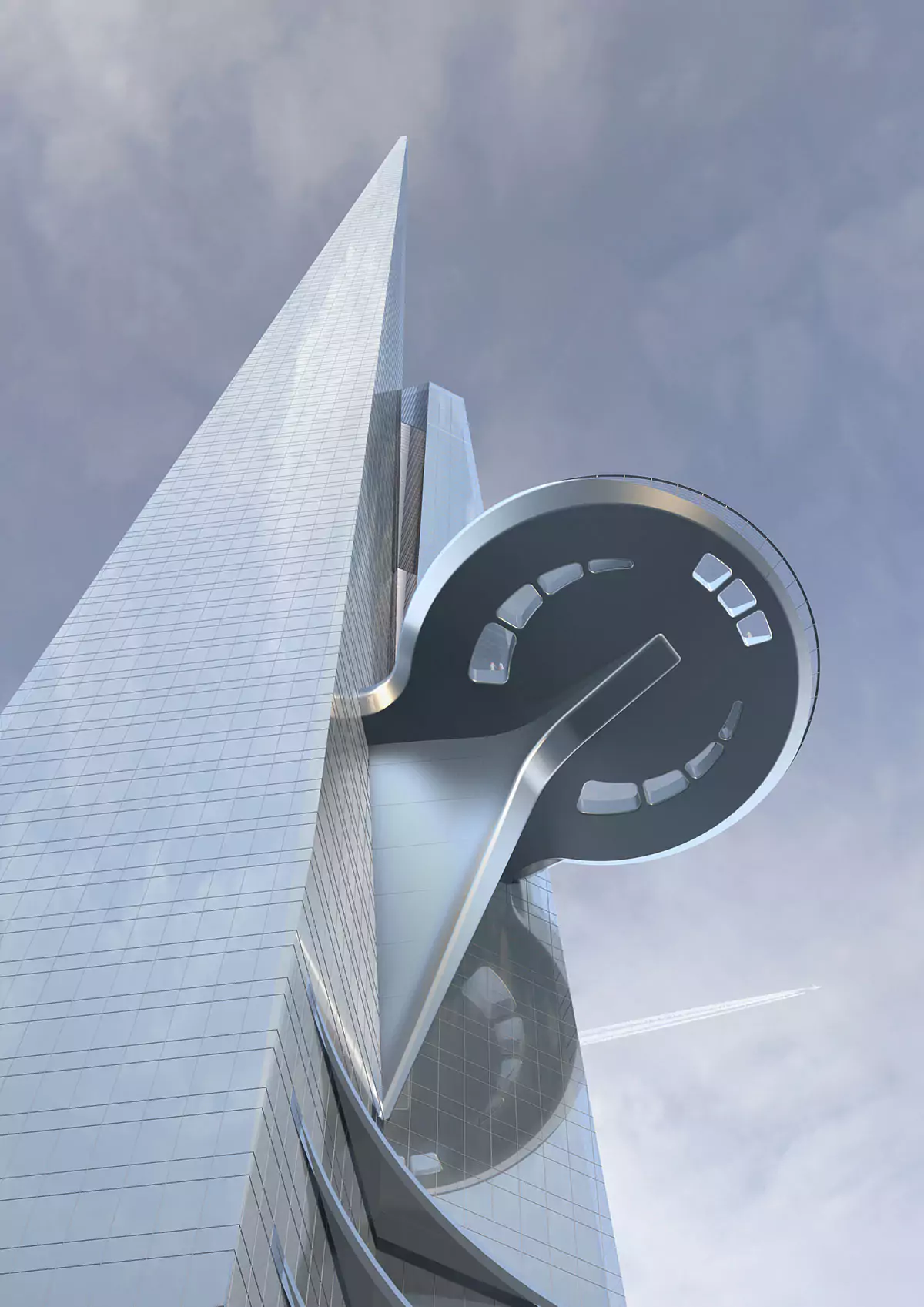
What architectural style is most prominent in Jeddah Tower?
The architectural style that is most prominent in the Jeddah Tower is neo-futurism. This style emerged relatively recently and centers on creating structures intended to represent the buildings of the future.
The Jeddah Tower possesses a distinctive tapered silhouette that evokes organic shapes like desert plant fronds unfurling upward. Its sleek, futuristic form reduces wind shear forces while visually suggesting themes of growth and prosperity.
The Jeddah Tower has other neo-futurist traits such as its triangular footprint for optimized space and views, high-tech building systems like double-decker elevators, and a mix of uses from hotel to residential. From the tower's high-performance envelope to its water conservation measures, sustainability is another neo-futuristic focus.
What structural engineering principles are employed in the construction of Jeddah Tower?
The Jeddah Tower, in its construction, employs several key structural engineering principles to support its immense planned height of over 1,000 meters (3,281 feet). The Jeddah Tower follows a similar architectural principle as the Burj Khalifa, utilizing a buttressed core design. The tower is designed with a hexagonal concrete core at its center, reinforced on three sides by large triangular wings, giving it a Y-shaped appearance from the side. The building’s strength and rigidity to resist lateral wind loads and vertical gravity loads are enhanced as a result. Its wings connect to the central core through heavy concrete walls and coupling beams, allowing loads to be efficiently transferred down the building.
The Jeddah Tower tapers continuously up its full height instead of using setbacks which creates an aerodynamic shape that allows wind vortices to detach from the building more easily, reducing structural loading. The tower’s smooth exterior profile maximizes leasable space and views compared to a stepped form. Its tapering shape was finalized with the help of wind tunnel testing. The building’s structural analyses then sized core dimensions and wall thicknesses to meet strength requirements with economies of material.
The Jedda Tower incorporates very high-strength concrete with compressive strengths in critical areas like the core walls and coupling beams, which provides enhanced durability and strength. Its foundation utilizes 270 bored reinforced concrete piles that reach 105 meters (344 feet) deep into the ground to provide stability below. The tower can combat the potential settlement of the massive structure through the implementation of these piles and the 5-meter-thick (16.4-foot-thick) raft above.
The Jeddah Tower’s structural system was designed for constructability, using slip-forming and jumpforming methods. Slip forming enables continuous, climb-form casting of the concrete core walls without difficult formwork. Jumpforming uses modular formwork moved floor-by-floor up the core. Both techniques ensure efficient, safe construction. The design avoids perimeter columns as well, keeping the tower free of vertical transfers. The tower, instead, leans on the stiffness of its reinforced concrete walls, minimizing construction complexity while maximizing rental space.
Who designed the Jeddah Tower?
The Jeddah Tower was designed by Adrian Smith, an American architect. As a partner at the architectural firm Adrian Smith + Gordon Gill Architecture (AS+GG) based in Chicago, Smith won a design competition in 2010 to create the plans for this landmark skyscraper in Jeddah, Saudi Arabia. Adrian Smith has designed the current world's tallest building during his tenure at Skidmore, Owings & Merrill as the chief designer, his significant experience with supertall towers makes him the ideal architect for the world’s next tallest building.
The Jeddah Tower uses a buttressed core layout structural design, a design pioneered with the Burj Khalifa by Adrian Smith. The buttressed core layout design involves a central hexagonal concrete core reinforced by three massive wings or buttresses arrayed in a Y-shape plan. The system resists wind and seismic forces extremely well by concentrating structural materials in these lateral and longitudinal walls while allowing the building to rise to great heights without columns. The tower’s designer fine-tuned the unique triple-winged silhouette with wind tunnel tests, allowing it to taper gracefully as it climbs into the clouds. The resulting form is highly aerodynamic and structurally efficient.
The Jeddah Tower’s designer Adrian Smith worked closely with the structural engineering firm Thornton Tomasetti to execute the engineering vision within his architectural envelope. Local consultants were brought on board to tailor the scheme to Saudi Arabia's extreme climate and available building materials. The simple yet bold structural concept allows primarily for reinforced concrete construction utilizing advanced self-climbing slipform techniques rather than difficult steelwork.
Adrian Smith stated in interviews that he aimed to create an elegant form evoking a bundle of newly sprouted desert plant fronds rising from the sand. The gracefully leaning profile would become a new symbol for Jeddah on the world stage while still being grounded by cultural and geographic context. If the Jeddah Tower’s construction goes ahead as planned, the finished 1+ kilometer-high building may well serve as the consummate demonstration of Smith's decades-honed skill in stretching the vertical limits of building technology.

What design influences are visible in Jeddah Tower?
The design influences visible in Jeddah Tower are: A three-winged buttressed core structural system, distinctive sloped and tapered exterior form, tri-petal footprint with angled fins that pays homage to traditional Arabian tents, high-performance exterior wall system, and a fusion of avant-garde and contextual elements attempts to reflect both international skyscraper design innovations as well as regional history and culture.
The Jeddah Tower employs a three-winged buttressed core structural system similar to the Burj Khalifa, which is designed for stability against winds and seismic activity. The tower reduces vortex shedding and optimizes rentable space with its distinctive sloped and tapered exterior form. Its design, drawing from Saudi Arabian architecture, mirrors traditional Arabian tents with wing-like fins creating distinctive light and shadow patterns. Jeddah Tower prioritizes sustainability, featuring an energy-efficient exterior wall system, renewable energy sources including solar panels, passive ventilation, and water efficiency measures like greywater recycling. It is an avant-garde skyscraper that reflects both design innovations and regional heritage and stands as a symbol of the Kingdom's modernization and ambitions.
How old is the Jeddah Tower?
The Jeddah Tower's full construction has yet to be completed but its foundations first took shape on Monday, April 1, 2013.
An iconic mixed-use mega-tall tower in Jeddah is a notion that was originally conceived in 2008 by Saudi Prince Alwaleed bin Talal. His ambitious goal was to construct the world's first 1-kilometer-high building and use its status as an engineering marvel to catapult Jeddah onto the global architectural scene. Alwaleed is the chairman of Kingdom Holding Company and the creative force driving the tower that would later carry the name of his firm.
The Jeddah Tower’s April Fools' Day groundbreaking on Monday, 1st of April 2013 marked the start of its structural life. Its construction crews worked for the remainder of the year to dig into the desert soil, installing huge foundational concrete piles to support the planned skyscraper. Jeddah Tower’s piling phase was fully completed by late December 2013.
The Jeddah Tower’s above-ground construction commenced in September 2014, incrementally adding levels to its concrete core over the next 3 years. Its progress photos from 2015 and 2016 showed the structure steadily rising, its central hexagonal shape giving hints of the intended final form. The Jeddah Tower had risen to 260 meters (853 feet) by late 2017, just over 5 years from its start, but that’s the tower’s last major construction milestone.

Why did the Jeddah Tower’s construction stop?
The Jeddah Tower’s construction stopped because the project faced several delays and challenges. The building owner JEC halted work on the tower in January 2018 when it was one-third completed, due to contractor payment issues tied to Saudi Arabia’s economic turmoil. The original visionary and key sponsor behind the Jeddah Tower concept, Saudi Prince Al-Waleed bin Talal, who was also responsible for the skyscraper's inception faced scrutiny about broader power reshuffling within the Kingdom hierarchy. This scrutiny contributed to the halting of work on the tower.
The Jeddah Tower’s construction has remained stalled since then. The building’s developer JEC issued a new tender in September 2023 to solicit bids from contractors to complete it, signaling a potential restart of the ambitious project.

Will the Jeddah Tower be completed?
The Jeddah Tower’s full completion remains uncertain, despite renewed construction efforts in 2023 after a 5-year hiatus. It faces enormous engineering, financial, and sustainability obstacles that must be overcome for its completion.
The tower faces huge engineering challenges due to its unprecedented height of over 1 kilometer. These include wind vortex shedding, elevator cable limitations, and floor sway/settling issues that become extreme at such heights. Structural failures are a greater risk the higher a skyscraper rises.
The Jeddah Tower’s immense financial requirements are difficult to sustain long-term. Delays inflate costs and require securing further funds though $1.2 billion was budgeted. Mega-projects like the Jeddah Tower often take a decade or more to finish. The unfinished building’s challenge is maintaining investor commitment, especially given the political uncertainty and purge of investors that started this 5-year stall.
The Jeddah Tower faces the challenge of harsh desert conditions, including sandstorms, high winds, and extreme temperatures, which accelerate deterioration and require robust construction methods.
What will Jeddah Tower be used for?
The Jeddah Tower will be used as a host for a variety of functions once complete: A branded five-star Four Seasons hotel with 200 high-end rooms and suites, opulent restaurants, spas, 97 Four Seasons-serviced apartments for longer-term tenants, with 7 being duplex units, and other premium hospitality featured drawn by the highly publicized record-setting height.
The Jeddah Tower, a fusion of luxury, business, and sightseeing, is set to house about 325 private apartments over 20 floors accessed by high-speed elevators. It will designate seven floors for Class A office spaces to cater to discerning corporations. The tower will feature the world's highest observation deck, offering panoramic views of Jeddah and the Red Sea, while featuring a 30-meter (98-foot) outdoor terrace. Jeddah Tower integrates all this with retail areas as well, weaving commerce and culture through every level. The cumulative vision is an unprecedented experience merging extreme height, luxury hospitality, elite residences, commercial offices, and sky-high sightseeing. The construction project aims to be a focal point that continually attracts tourists, tenants, and economic growth.
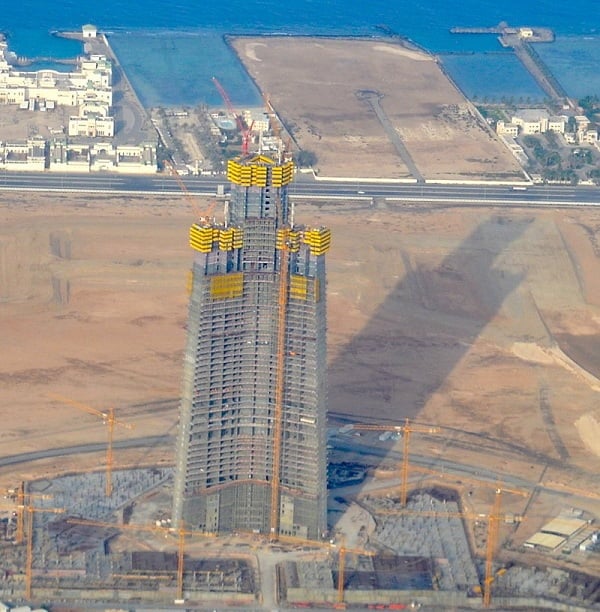
Who owns Jedah Tower?
Jeddah Economic Company (JEC) owns Jeddah Tower. JEC is a consortium formed by several holding companies, including Kingdom Holding Company which proposed the project, Saudi BinLaden Group which is the main contractor, and some other investment companies. Kingdom Holding Company has a 33.35% stake in JEC, while Saudi Bin Laden Group owns 16.63%.
Saudi Prince Al-Waleed bin Talal originally proposed the Jeddah Tower. Saudi Prince Al-Waleed bin Talal is the chairman of Kingdom Holding Company and one of the richest men in the Middle East, his vision was to construct an iconic tower that would put Jeddah and Saudi Arabia on the global architectural map.
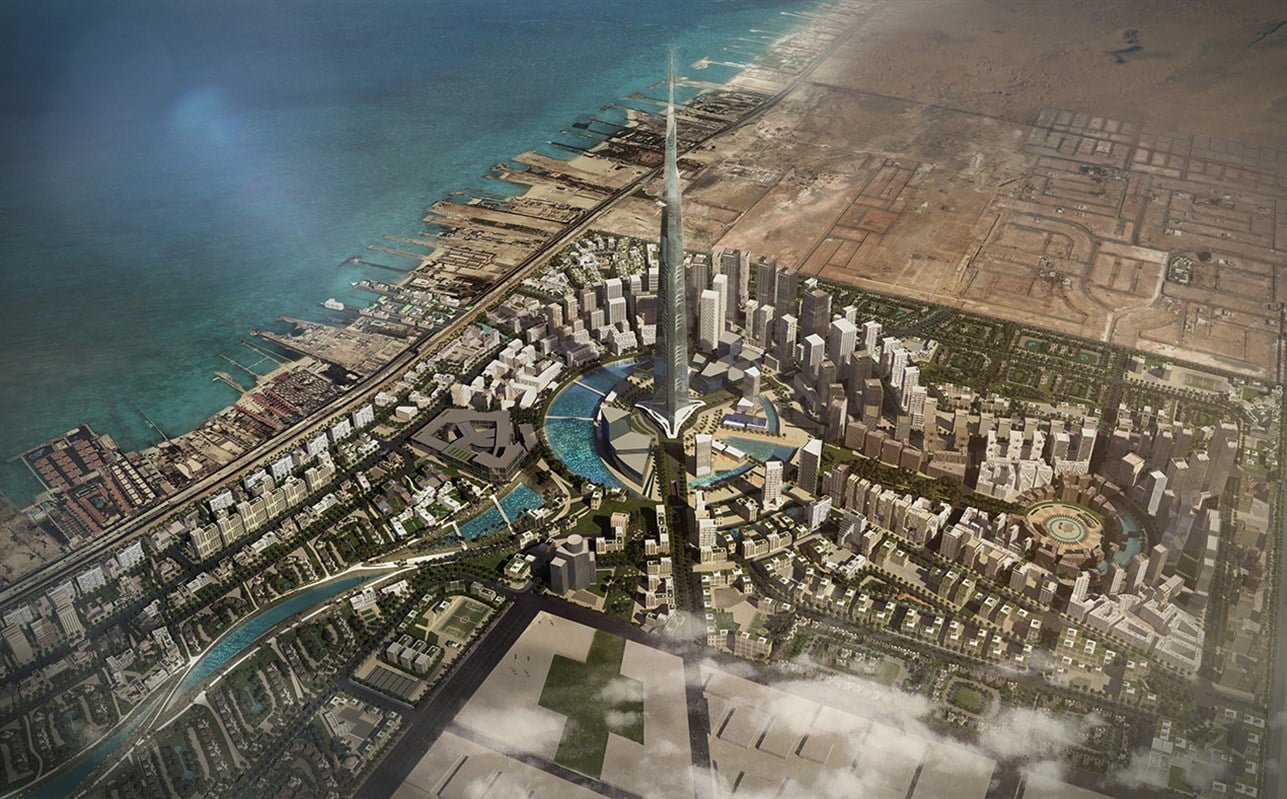
Is there a Jeddah Tower camera live feed?
A live camera feed for the Jeddah Tower construction site is not available. The developer, Jeddah Economic Company, previously had a live cam feed on their website, but it is currently unavailable.
The live cam provided a view of the construction site from a nearby tower in the past, giving updates on the progress of the building. It allowed people to watch as the concrete superstructure rose higher into the Jeddah skyline. The feed was turned off when construction stalled in January 2018 when the building reached 260 meters (853 feet) or 63 floors. The last available images from December 2016 show the tower standing at around 250 meters (820 feet) tall. There have been no new official updates from the developers on the tower's status, let alone a live camera feed since the construction halt over 5 years ago.
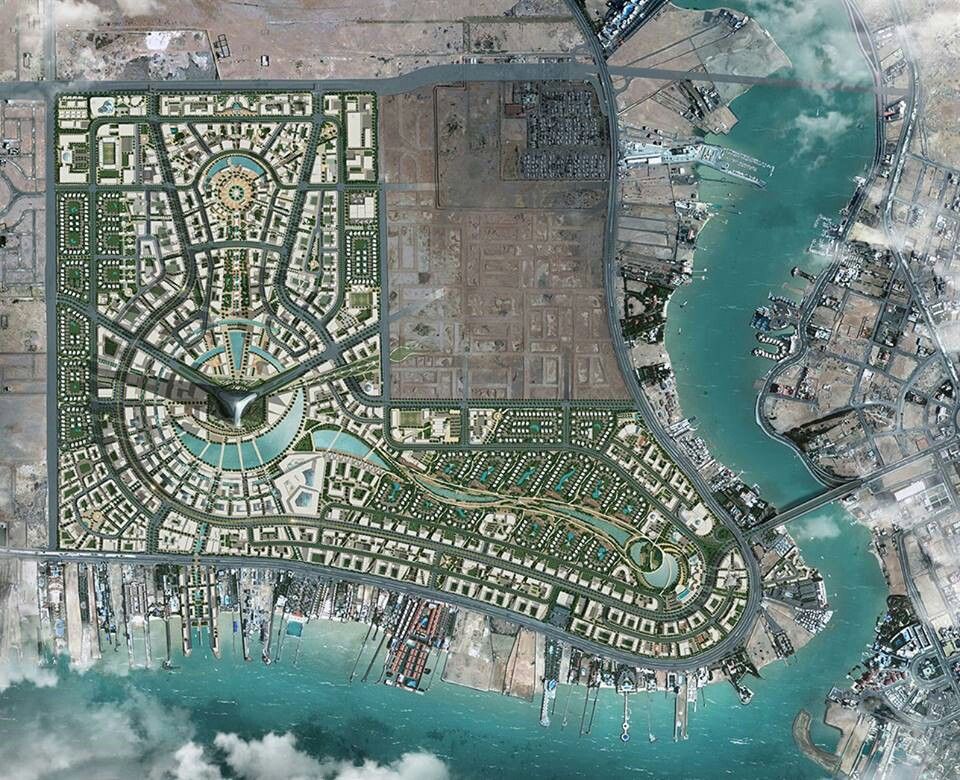
Is Jeddah Tower bigger than Burj Khalifa?
Yes, Jeddah Tower is designed to be taller than the iconic Burj Khalifa in Dubai. The tower’s completed height is planned to reach over 1,000 meters (3,281 feet), making it at least 173 meters (568 feet) taller than the Burj Khalifa's height of 828 meters (2,717 feet). Jeddah Tower is designed to have a larger overall floor area compared to Burj Khalifa. Plans show the Jeddah Tower has 530,000 square meters (5.7 million square feet) of total floor space while Burj Khalifa, in contrast, has an overall floor area of 309,473 square meters (3.3 million square feet).
The Jeddah Tower, if completed as envisioned, would not only surpass the Burj Khalifa's height record by a significant margin but would also eclipse it in terms of internal floor space. This truly massive scale is what leads developers to bill Jeddah Tower as the next "world's tallest building."

What is bigger than the Burj Khalifa?
Jeddah Tower is set to be much bigger than the current tallest building in the world, the Burj Khalifa in Dubai. The tower is designed in a futuristic, neo-futurist style by architect Adrian Smith. The building aims to be a new global icon that will put Jeddah and Saudi Arabia prominently on the world map.
The Jeddah Tower, once completed, will reach an estimated height of at least 1,000 meters (3,281 feet) while the Burj Khalifa stands at 828 meters (2,717 feet) tall. So the Jeddah Tower is expected to exceed the Burj Khalifa's height by at least 172 meters, or over 563 feet. The Jeddah Tower will have more floors as well - around 167 habitable floors are planned, compared to Burj Khalifa's 163 occupiable floors.
The Jeddah Tower’s other record-breaking aspects include the tallest observatory in the world, estimated to top out at around 652 meters (2,139 feet) high. This will handily beat Burj Khalifa's observatory called At the Top SKY, which sits 555 meters (1,821 feet) high. The building plans to have the world's highest outdoor balcony, called a sky terrace, at approximately 660 meters (2,165 feet) high. Its visitors will be able to step outside and have a unique view overlooking Jeddah and Saudi Arabia's Red Sea coastline from this lofty height.
The Jeddah Tower will utilize many advanced technologies and design efficiencies to account for the strong winds and pressures at such extreme heights: A 3-sided, aerodynamic exterior and strong central core structuring that utilizes reinforced concrete and steel. A tapered shape will minimize wind vortex shedding as well and the skyscraper will have the world's fastest elevators traveling at 10 meters (33 feet) per second.
The Jeddah Tower’s completion in the future promises to deliver new heights and views never seen as its visionary design and construction aims to push tall building engineering to unprecedented levels as a symbol of innovation in Saudi Arabia.
What are the tallest buildings in the world?
The tallest buildings in the world are Jeddah Tower, Burj Khalifa, Merdeka 118, Shanghai Tower, Makkah Royal Clock Tower, Ping An Finance Center, Lotte World Tower, One World Trade Center, Guangzhou CTF Finance Centre, Tianjin CTF Finance Center, and China Zun Tower.
Firstly, Jeddah Tower in Saudi Arabia which was designed by Adrian Smith aims to be the world's tallest building standing over 1,000 meters (3,281 feet). The tower's ambitious construction plans include over 200 floors filling a gross area of 530,000 square meters (5.7 million square feet), housing an array of luxurious residences, offices, and a top-level observatory. Secondly, Burj Khalifa in Dubai holds the record as the world's tallest building at 828 meters (2,717 feet) tall, completed in 2010 after 6 years of construction. It features a diverse mix of leisure, commercial, and residential spaces including the Armani Hotel Dubai, offering global tourists a grand spectacle of Dubai's economic ambitions.
Thirdly, Merdeka 118 is currently the world's second tallest building at 678.9 meters (2,227 feet) and was completed in early 2023. Located in Kuala Lumpur, Malaysia, Merdeka 118 is a 118-floor tower that symbolizes Malaysian diversity and independence and has a diverse range of urban facilities adjacent to the historic Stadium Merdeka. Fourthly, Shanghai Tower is currently China's tallest building and the third tallest globally with its 128 floors reaching 632 meters (2,073 feet) into the clouds. It integrates retail, hospitality, and commercial spaces including nine indoor zones and an observation deck, echoing Shanghai's prestige as an upcoming global finance hub.
Fifthly, Makkah Royal Clock Tower in Mecca, standing 601 meters (1,972 feet) tall, was completed in 2012 as part of the King Abdulaziz Endowment Project. This building is visible from 30 kilometers away and it provides luxurious accommodations for pilgrims near the Great Mosque of Mecca. Sixthly, Ping An Finance Center in Shenzhen, China was completed in 2017 at 599 meters (1,965 feet), named after the insurance company it hosts. It features office space, retail outlets, and the city’s highest observation deck, with a high-tech double-layered glass facade that enhances its stature.
Seventhly, Lotte World Tower in Seoul, South Korea stands tall at 555 meters (1,821 feet) and was completed at the end of 2016, boasting the world’s highest glass-bottomed observation deck, luxury residences, offices, and retail spaces, reinforcing Seoul’s position as a key Asian metropolis. Eighthly, One World Trade Center in New York City stands symbolically at 541 meters (1,776 feet) and serves as an icon of resilience. The tower features cutting-edge safety technologies with a mix of major media, finance, tech, and government tenants enhancing the city's stature.
Ninthly, Guangzhou CTF Finance Centre boasts the world’s fastest elevators and a commanding presence in Guangzhou’s business district. It is a 530-meter (1,739-foot) mixed-use supertall tower that was completed in 2016. Tenthly, Tianjin CTF Finance Center, completed in 2019, stands 530 meters (1,739 feet) tall with a vast public podium. It houses office space, residences, a hotel, and retail outlets in Tianjin’s central business district.
Lastly, China Zun Tower, at a height of 527 meters (1,731 feet), was completed in 2018 in Beijing and serves as headquarters for the CITIC Group conglomerate. The architectural landmark optimizes workspace with large open floor plans and is situated in Beijing’s burgeoning Central Business District.
